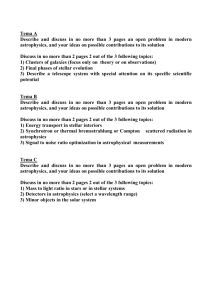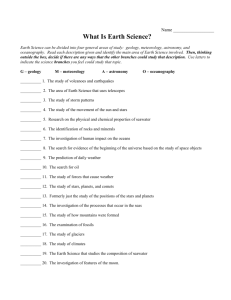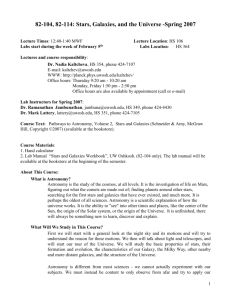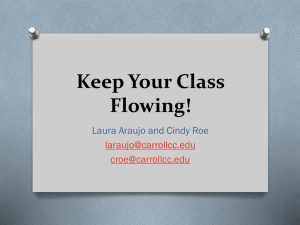Beyond Astro 101
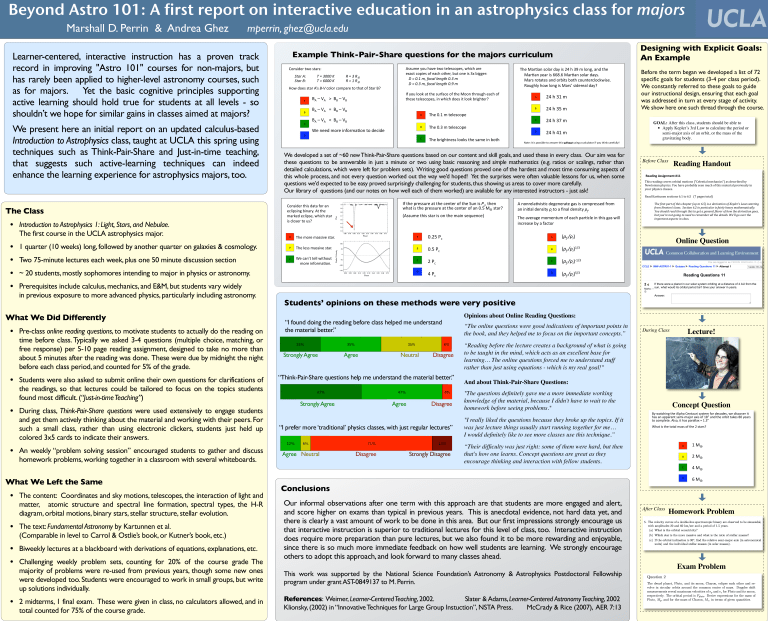
Beyond Astro 101: A first report on interactive education in an astrophysics class for majors
Marshall D. Perrin & Andrea Ghez mperrin, ghez@ucla.edu
Learner-centered, interactive instruction has a proven track record in improving "Astro 101" courses for non-majors, but has rarely been applied to higher-level astronomy courses, such as for majors. Yet the basic cognitive principles supporting active learning should hold true for students at all levels - so shouldn’t we hope for similar gains in classes aimed at majors?
We present here an initial report on an updated calculus-based
Introduction to Astrophysics class, taught at UCLA this spring using techniques such as Think-Pair-Share and Just-in-time teaching, that suggests such active-learning techniques can indeed enhance the learning experience for astrophysics majors, too.
The Class
•
Introduction to Astrophysics 1: Light, Stars, and Nebulae.
The first course in the UCLA astrophysics major.
• 1 quarter (10 weeks) long, followed by another quarter on galaxies & cosmology.
• Two 75-minute lectures each week, plus one 50 minute discussion section
• ~ 20 students, mostly sophomores intending to major in physics or astronomy.
• Prerequisites include calculus, mechanics, and E&M, but students vary widely in previous exposure to more advanced physics, particularly including astronomy.
Example Think-Pair-Share questions for the majors curriculum
!"#$%&'()*+")$*,($-)
) !"#$%&' % %(%)%*+++%, % %-%)%*%-
) !"#$%.' % %(%)%/+++%, % %-%)%0%-
!"
!
)
."+)&"'$)$*,()/0$) .12
)1"2"()1"34,(')*")*5,*)"6)7*,()89))
/)
8)
!)
8
/
):);
/
)))<))8
8
):);
8)
8
/
):);
/
)))=))8
8
):);
8)
8
/
):);
/
)))>))8
8
):);
8)
?')#''&)3"(')%#6"(3,@"#)*")&'1%&')
A)
!""#$%&'(#&)*+%&,-(&,%.%"/(0%"1&-)2/)&*3%&&
%4*/,&/(02%"&(5&%*/)&(,)%31&6#,&(7%&2"&84&6299%3:&&
!!!"!#!$%&!'(!)*+,-!-./012!$%3!'!
!!!"!#!$%3!'(!)*+,-!-./012!$%4!'!
;5&'(#&.((<&*,&,)%&"#35*/%&(5&,)%&=((7&,)3(#9)&%*/)&(5&
,)%"%&,%.%"/(0%"1&27&-)2/)&>(%"&2,&.((<&6329),%3?&
!&
B)%&CDE&$&,%.%"/(0%&
@&
A&
B)%&CD8&$&,%.%"/(0%&
B)%&6329),7%""&.((<"&,)%&"*$%&27&6(,)&
&'(")*+,*-"./0*+"1*2"3."45"'"67"8"0/-9:"*-1";'("
)*+,*-"2(*+"3."<<=><")*+,*-"./0*+"1*2.>"
)*+."+/;*;(."*-1"/+?3;."?/;'"@/A-;(+@0/@BC3.(>"
D/A9'02"'/C"0/-9"3.")*+.E".31(+(*0"1*2F"
!"
45"'"6G"8"
#"
45"'"6H"8"
$" 45"'"6I"8"
%" 45"'"5G"8"
J/;(K"L;"3."M/..3?0(";/"*-.C(+";'3." !"#$%&#' A.3-9"*"@*0@A0*;/+"3N"2/A";'3-B"@*+(NA002O"
We developed a set of ~60 new Think-Pair-Share questions based on our content and skill goals, and used these in every class. Our aim was for these questions to be answerable in just a minute or two using basic reasoning and
simple
mathematics (e.g. ratios or scalings, rather than detailed calculations, which were left for problem sets). Writing good questions proved one of the hardest and most time consuming aspects of this whole process, and not every question worked out the way we’d hoped! Yet the surprises were often valuable lessons for us, when some questions we’d expected to be easy proved surprisingly challenging for students, thus showing us areas to cover more carefully.
Our library of questions (and our notes on how well each of them worked) are available for any interested instructors - just ask!
!"#$%&'()*+%$)&,*,)-"(),#)
'./%0$%#1)2%#,(34)5*)*+')
6,(7'&)'./%0$'8)9+%.+)$*,()
%$)./"$'()*"):$;)
!"#$%&#'(&))*(&#+$#$%&#,&-$&(#."#$%&#/*-#0)# !
"
1#$%&-#
2%+$#0)#$%&#'(&))*(&#+$#$%&#,&-$&(#."#+-#345#6
!
#)$+(7#
89))*:&#$%0)#)$+(#0)#.-#$%&#:+0-#)&;*&-,&<##
!"#$#%&'()*+,)-".&/&#&%(0&"/(,"+,"-$12%&,,&."3%$1"
!"#$#%&'()*+,)-".&/&#&%(0&"/(,"+,"-$12%&,,&."3%$1"
(#"+#+)('".&#,+04" !
" "
0$"("5#('".&#,+04" !
0$"("5#('".&#,+04" !
#
6""
#
6""
78&"(*&%(/&"1$1["$3"&(-8"2(%)-'&"+#"08+,"/(,":+''"
78&"(*&%(/&"1$1["$3"&(-8"2(%)-'&"+#"08+,"/(,":+''"
+#-%&(,&";4"("3(-0$%"
5) =+')6"(')6,$$%>')$*,(4)
<) =+')/'$$)6,$$%>')$*,(4)
!)
?').,#@*)*'//)9%*+":*)
6"(')%#-"(6,A"#4)
9#
=#
>#
?#
34@5#A
,#
345#A
,#
@#A
,#
B#A
,#
="
="
>"
>"
!"
!"
<"
<"
?
!
?
!
#$
#$
%!
%!
"
"
@"
@"
?
!
?
!
#$
#$
%!
%!
"
"
@ ABC
@ ABC "
"
?
!
?
!
#$
#$
%!
%!
"
"
@ DABC
@ DABC "
"
?
!
?
!
#$
#$
%!
%!
"
"
@ EBC
@ EBC "
"
Designing with Explicit Goals:
An Example
Before the term began we developed a list of 72 specific goals for students (3-4 per class period).
We constantly referred to these goals to guide our instructional design, ensuring that each goal was addressed in turn at every stage of activity.
We show here one such thread through the course.
GOAL: After this class, students should be able to
• Apply Kepler’s 3rd Law to calculate the period or semi-major axis of an orbit, or the mass of the gravitating body.
!
Before Class
!
!
!
!
!
Reading Handout
"#$%#!&'()*!*(!+,-*./!0-%#.*-(1+!&10!+2#10!(1#!.3&++!.(4#%-15!5%&4-*6!&10!(%'-*+7!+(!
*/&*!,#!.&1!&2236!*/&*!81(,3#05#!*(!()%!+*)06!(9!+*&%+:!!
;/-+!%#&0-15!.(4#%+!(%'-*&3!<(*-(1+!=>?#3#+*-&3!<#./&1-.+@A!&+!0#+.%-'#0!'6!
B#,*(1-&1!2/6+-.+:!C()!/&4#!2%('&'36!+##1!<)./!(9!*/-+!<&*#%-&3!2%#4-()+36!-1!
!
!
!
!
!"#$%&'()**%'&+"&,(-..((
*/&*!,#!.&1!&2236!*/&*!81(,3#05#!*(!()%!+*)06!(9!+*&%+:!!
D#&0!E&%**)1#1!+#.*-(1+!F:G!*(!F:H!!!=I!2&5#+!*(*&3A!
!"#$%&'()$*+')$,%$)"&($-"+*)#'$./*$),$0123$&($+$4#'&5+)&,6$,%$7#*8#'9($:+;($()+')&6<$
%',=$>#;),69($8+;(1$$?#-)&,6$01@$&6$*+')&-/8+'$&($%+&'8A$"#+5A$=+)"#=+)&-+88A1$$
B,/$(",/84$'#+4$)"',/<"$)"&($),$<#)$+$<#6#'+8$%8+5,'$,%$",;$)"#$4#'&5+)&,6$<,#(C$
D/)$A,/9'#$6,)$<,&6<$),$6##4$),$'#=#=D#'$+88$)"#$4#)+&8(1$E#988$<,$,5#'$)"#$
%',=$>#;),69($8+;(1$$?#-)&,6$01@$&6$*+')&-/8+'$&($%+&'8A$"#+5A$=+)"#=+)&-+88A1$$
!"#$=,()$&=*,')+6)$*+')($,%$)"&($'#+4&6<$&($(#-)&,6$01F$.7#*8#'9($G
.7#*8#'9($@ 64 $+64$F '4 $8+;(31$$$7#*8#'9($F '4
() $8+;3$+64$012$
$8+;$&6$*+')&-/8+'$&($5#'A$/(#%/8$+64$&($
!
!"#$=,()$&=*,')+6)$*+')($,%$)"&($'#+4&6<$&($(#-)&,6$01F$.7#*8#'9($G () $8+;3$+64$012$
.7#*8#'9($@ 64
Online Question
;,')"$-,==&))&6<$),$=#=,'A1$$
'4 $8+;$&6$*+')&-/8+'$&($5#'A$/(#%/8$+64$&($
!
You are logged in as PERRIN MARSHALL D.
( Logout
CCLE !
09W-ASTR81-1 !
Quizzes !
Reading Questions 11 !
Attempt 1
Update this Quiz
Reading Questions 11
2
Marks: --
/3
If there were a planet in our solar system orbiting at a distance of 4 AU from the sun, what would its orbital period be? Give your answer in years.
Answer:
What We Did Differently
• Pre-class
online reading questions
, to motivate students to actually do the reading on time before class. Typically we asked 3-4 questions (multiple choice, matching, or free response) per 5-10 page reading assignment, designed to take no more than about 5 minutes after the reading was done. These were due by midnight the night before each class period, and counted for 5% of the grade.
• Students were also asked to submit online their own questions for clarifications of the readings, so that lectures could be tailored to focus on the topics students found most difficult. (
“Just-in-time Teaching”
)
• During class,
Think-Pair-Share questions
were used extensively to engage students and get them actively thinking about the material and working with their peers. For such a small class, rather than using electronic clickers, students just held up colored 3x5 cards to indicate their answers.
• An weekly “problem solving session” encouraged students to gather and discuss homework problems, working together in a classroom with several whiteboards.
What We Left the Same
• The content: Coordinates and sky motions, telescopes, the interaction of light and matter, atomic structure and spectral line formation, spectral types, the H-R diagram, orbital motions, binary stars, stellar structure, stellar evolution.
• The text:
Fundamental Astronomy
by Kartunnen et al.
(Comparable in level to Carrol & Ostlie’s book, or Kutner’s book, etc.)
• Biweekly lectures at a blackboard with derivations of equations, explanations, etc.
• Challenging weekly problem sets, counting for 20% of the course grade The majority of problems were re-used from previous years, though some new ones were developed too. Students were encouraged to work in small groups, but write up solutions individually.
• 2 midterms, 1 final exam. These were given in class, no calculators allowed, and in total counted for 75% of the course grade.
Students’ opinions on these methods were very positive
“I found doing the reading before class helped me understand the material better.”
Opinions about Online Reading Questions:
“The online questions were good indications of important points in the book, and they helped me to focus on the important concepts.”
Strongly Agree Agree Neutral
Disagree
“Reading before the lecture creates a background of what is going to be taught in the mind, which acts as an excellent base for learning… The online questions forced me to understand stuff rather than just using equations - which is my real goal!"
“Think-Pair-Share questions help me understand the material better.”
Strongly Agree Agree
Disagree
“I prefer more ‘traditional’ physics classes, with just regular lectures”
Agree Neutral
Disagree
Strongly Disagree
And about Think-Pair-Share Questions:
"The questions definitely gave me a more immediate working knowledge of the material, because I didn't have to wait to the homework before seeing problems."
"I really liked the questions because they broke up the topics. If it was just lecture things usually start running together for me…
I would definitely like to see more classes use this technique.”
“Their difficulty was just right: some of them were hard, but then that's how one learns. Concept questions are great as they encourage thinking and interaction with fellow students.
Conclusions
Our informal observations after one term with this approach are that students are more engaged and alert, and score higher on exams than typical in previous years. This is anecdotal evidence, not hard data yet, and there is clearly a vast amount of work to be done in this area. But our first impressions strongly encourage us that interactive instruction is superior to traditional lectures for this level of class, too. Interactive instruction does require more preparation than pure lectures, but we also found it to be more rewarding and enjoyable, since there is so much more immediate feedback on how well students are learning. We strongly encourage others to adopt this approach, and look forward to many classes ahead.
This work was supported by the National Science Foundation’s Astronomy & Astrophysics Postdoctoral Fellowship program under grant AST-0849137 to M. Perrin.
References : Weimer, Learner-Centered Teaching , 2002. Slater & Adams, Learner-Centered Astronomy Teaching , 2002
Klionsky, (2002) in “Innovative Techniques for Large Group Instuction”, NSTA Press. McCrady & Rice (2007), AER 7:13
During Class
Lecture!
Concept Question
!"#$%&'()*+#&(,#-./(%#0,*&%12)#3"3&,4#562#7,'%7,38#$,#7)3'69,2#)&#
(%3#%*#%//%2,*,4):4%;62#%<)3#65#=>?#%*7#&(,#62@)&#&%A,3#>B#",%23#
&6#'64/.,&,C#-.368#)&#(%3#/%2%..%<#D#=CE?#
F(%&#)3#&(,#&6&%.#4%33#65#&(,#G#3&%23H## due Friday February 27 before noon
-#
=#J
!
#
1. Find the ratio of the orbital velocities at aphelion and perihelion V ratio for the Earth?
!#
G#J
!"
2. How dense are stars?
/V . What is this
(a) From the angular diameter of the Sun and the length of the year, derive the mean density of the Sun.
0#
K#J
!
#
(b) The red supergiant star Betelgeuse has spectral type M2 I, corresponding to a
L#J
!
# ff ective temperature of 3500
. What is its mean density? How does this value compare to the Sun’s?
3. If high mass stars are more massive than low mass stars, how can most of the mass in our Galaxy be in the form of low mass stars? If most of the mass is in low mass stars, how can most of the luminosity come from high mass stars?
4. The components of a binary move along circular orbits. The mutual distance is 1
After Class M
Homework Problem
nanometers) of the components of the H γ line?
. An observer in the plane of the orbit will see periodic splitting of the spectral lines. What is the maximum separation (in
5. The velocity curves of a double-line spectroscopic binary are observed to be sinusoidal, with amplitudes 20 and 60 km/sec and a period of 1.5 years.
(a) What is the orbital eccentricity?
(b) Which star is the more massive and what is the ratio of stellar masses?
(c) If the orbital inclination is 90 , find the relative semi-major axis (in astronomical units) and the individual stellar masses (in solar masses).
6. The e ff ective temperature of one component of an eclipsing binary is 15,000 K, and that of the other is 5,000 K. The cooler star is a giant with a radius four times that of the hotter star.
(a) What is the ratio of stellar luminosities?
(d) How many times deeper is primary minimum versus secondary minimum (in energy
1 measurements reveal maximum velocities of v respectively. The orbital period is P
Pluto, M , and for the mass of Charon, M and v


